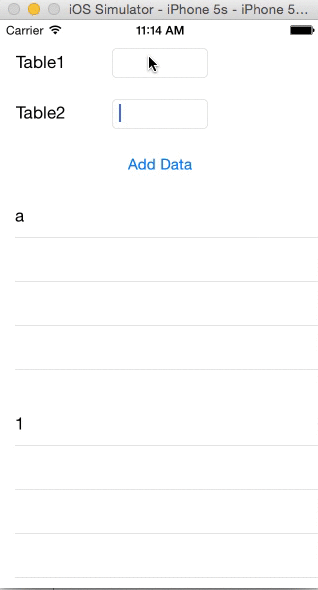How to insert new cell into UITableView in Swift
I'm working on a project where I have two UITableViews and two UITextFields, when the user presses the button the data in the first textField should go into the tableView and the second go into the second tableView. My problem is that I don't know how to put data in the tableView each time the user pushes the button, I know how to insert data with tableView:cellForRowAtIndexPath: but that works for one time as far as I know. So what method can I use to update the tableView each time the user hits the button?
Use beginUpdates and endUpdates to insert a new cell when the button clicked.
As @vadian said in comment,
begin/endUpdateshas no effect for a single insert/delete/move operation
First of all, append data in your tableview array
Yourarray.append([labeltext])
Then update your table and insert a new row
// Update Table Data
tblname.beginUpdates()
tblname.insertRowsAtIndexPaths([
NSIndexPath(forRow: Yourarray.count-1, inSection: 0)], withRowAnimation: .Automatic)
tblname.endUpdates()
This inserts cell and doesn't need to reload the whole table but if you get any problem with this, you can also use tableview.reloadData()
Swift 3.0
tableView.beginUpdates()
tableView.insertRows(at: [IndexPath(row: yourArray.count-1, section: 0)], with: .automatic)
tableView.endUpdates()
Objective-C
[self.tblname beginUpdates];
NSArray *arr = [NSArray arrayWithObject:[NSIndexPath indexPathForRow:Yourarray.count-1 inSection:0]];
[self.tblname insertRowsAtIndexPaths:arr withRowAnimation:UITableViewRowAnimationAutomatic];
[self.tblname endUpdates];
Swift 5.0, 4.0, 3.0 Updated Solution
Insert at Bottom
self.yourArray.append(msg)
self.tblView.beginUpdates()
self.tblView.insertRows(at: [IndexPath.init(row: self.yourArray.count-1, section: 0)], with: .automatic)
self.tblView.endUpdates()
Insert at Top of TableView
self.yourArray.insert(msg, at: 0)
self.tblView.beginUpdates()
self.tblView.insertRows(at: [IndexPath.init(row: 0, section: 0)], with: .automatic)
self.tblView.endUpdates()
Here is your code for add data into both tableView:
import UIKit
class ViewController: UIViewController, UITableViewDelegate, UITableViewDataSource {
@IBOutlet weak var table1Text: UITextField!
@IBOutlet weak var table2Text: UITextField!
@IBOutlet weak var table1: UITableView!
@IBOutlet weak var table2: UITableView!
var table1Data = ["a"]
var table2Data = ["1"]
override func viewDidLoad() {
super.viewDidLoad()
}
@IBAction func addData(sender: AnyObject) {
//add your data into tables array from textField
table1Data.append(table1Text.text)
table2Data.append(table2Text.text)
dispatch_async(dispatch_get_main_queue(), { () -> Void in
//reload your tableView
self.table1.reloadData()
self.table2.reloadData()
})
table1Text.resignFirstResponder()
table2Text.resignFirstResponder()
}
//delegate methods
func numberOfSectionsInTableView(tableView: UITableView) -> Int {
return 1
}
func tableView(tableView: UITableView, numberOfRowsInSection section: Int) -> Int {
if tableView == table1 {
return table1Data.count
}else if tableView == table2 {
return table2Data.count
}
return Int()
}
func tableView(tableView: UITableView, cellForRowAtIndexPath indexPath: NSIndexPath) -> UITableViewCell {
if tableView == table1 {
let cell = table1.dequeueReusableCellWithIdentifier("Cell", forIndexPath: indexPath) as! UITableViewCell
let row = indexPath.row
cell.textLabel?.text = table1Data[row]
return cell
}else if tableView == table2 {
let cell = table2.dequeueReusableCellWithIdentifier("Cell1", forIndexPath: indexPath) as! UITableViewCell
let row = indexPath.row
cell.textLabel?.text = table2Data[row]
return cell
}
return UITableViewCell()
}
}
And your result will be:
